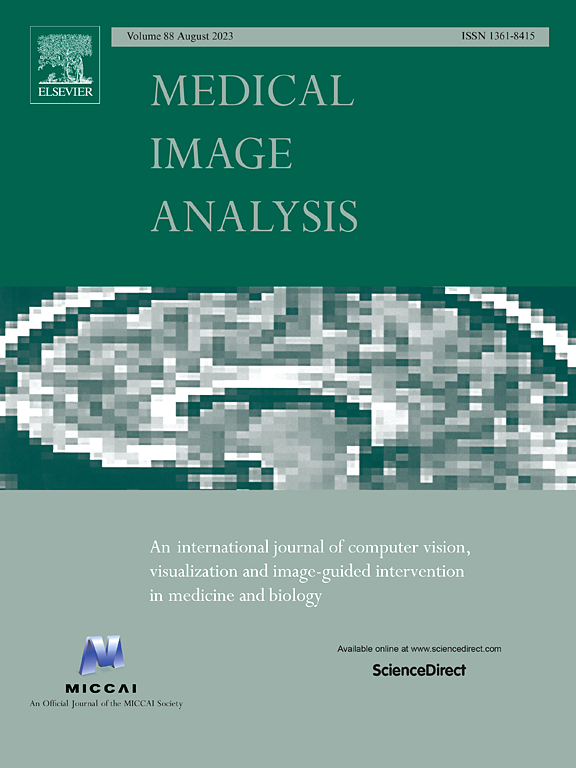Self-knowledge distillation-empowered directional connectivity transformer for microbial keratitis biomarkers segmentation on slit-lamp photography
IF 10.7
1区 医学
Q1 COMPUTER SCIENCE, ARTIFICIAL INTELLIGENCE
引用次数: 0
Abstract
The lack of standardized, objective tools for measuring biomarker morphology poses a significant obstacle to managing Microbial Keratitis (MK). Previous studies have demonstrated that robust segmentation benefits MK diagnosis, management, and estimation of visual outcomes. However, despite exciting advances, current methods cannot accurately detect biomarker boundaries and differentiate the overlapped regions in challenging cases. In this work, we propose a novel self-knowledge distillation-empowered directional connectivity transformer, called SDCTrans. We utilize the directional connectivity modeling framework to improve biomarker boundary detection. The transformer backbone and the hierarchical self-knowledge distillation scheme in this framework enhance directional representation learning. We also propose an efficient segmentation head design to effectively segment overlapping regions. This is the first work that successfully incorporates directional connectivity modeling with a transformer. SDCTrans trained and tested with a new large-scale MK dataset accurately and robustly segments crucial biomarkers in three types of slit lamp biomicroscopy images. Through comprehensive experiments, we demonstrated the superiority of the proposed SDCTrans over current state-of-the-art models. We also show that our SDCTrans matches, if not outperforms, the performance of expert human graders in MK biomarker identification and visual acuity outcome estimation. Experiments on skin lesion images are also included as an illustrative example of SDCTrans’ utility in other segmentation tasks. The new MK dataset and codes are available at https://github.com/Zyun-Y/SDCTrans.

在狭缝灯摄影上对微生物角膜炎生物标志物进行分割的自我知识蒸馏授权的定向连接转换器。
缺乏标准化、客观的测量生物标志物形态的工具是管理微生物性角膜炎(MK)的重大障碍。先前的研究表明,稳健的分割有利于MK的诊断、管理和视觉结果的估计。然而,尽管取得了令人兴奋的进展,但目前的方法无法准确检测生物标志物边界,并在具有挑战性的情况下区分重叠区域。在这项工作中,我们提出了一种新的自我知识蒸馏授权的定向连接变压器,称为SDCTrans。我们利用定向连通性建模框架来改进生物标志物的边界检测。该框架中的变压器主干和分层自知识升华方案增强了定向表示学习。我们还提出了一种高效的分割头设计,以有效地分割重叠区域。这是第一次成功地将定向连接建模与变压器结合在一起。SDCTrans经过大规模MK数据集的训练和测试,在三种类型的裂隙灯生物显微镜图像中准确而稳健地分割关键生物标志物。通过综合实验,我们证明了所提出的SDCTrans优于当前最先进的模型。我们还表明,我们的SDCTrans在MK生物标志物鉴定和视力结果估计方面的表现与人类专家评分者相当,如果不是优于他们的话。在皮肤病变图像上的实验也包括作为SDCTrans在其他分割任务中的实用性的一个示例。新的MK数据集和代码可在https://github.com/Zyun-Y/SDCTrans上获得。
本文章由计算机程序翻译,如有差异,请以英文原文为准。
求助全文
约1分钟内获得全文
求助全文
来源期刊

Medical image analysis
工程技术-工程:生物医学
CiteScore
22.10
自引率
6.40%
发文量
309
审稿时长
6.6 months
期刊介绍:
Medical Image Analysis serves as a platform for sharing new research findings in the realm of medical and biological image analysis, with a focus on applications of computer vision, virtual reality, and robotics to biomedical imaging challenges. The journal prioritizes the publication of high-quality, original papers contributing to the fundamental science of processing, analyzing, and utilizing medical and biological images. It welcomes approaches utilizing biomedical image datasets across all spatial scales, from molecular/cellular imaging to tissue/organ imaging.
 求助内容:
求助内容: 应助结果提醒方式:
应助结果提醒方式:


